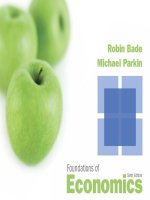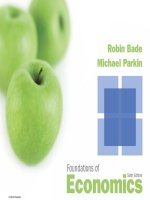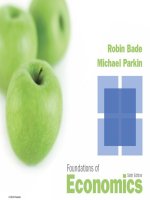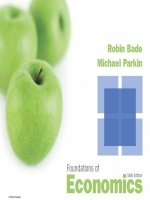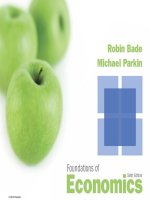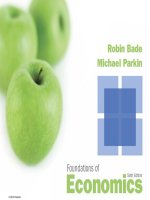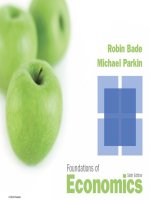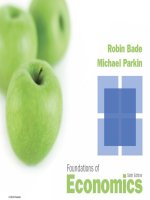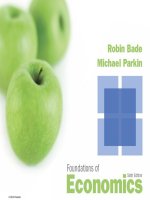Foundations of economics 6th by parkin ch01 clicker questions
Bạn đang xem bản rút gọn của tài liệu. Xem và tải ngay bản đầy đủ của tài liệu tại đây (224.01 KB, 13 trang )
Click
Clickon
onthe
thebutton
buttontotogo
gototothe
theQuestion
problem
© 2013 Pearson
Getting Started
1
CLICKER QUESTIONS
© 2013 Pearson
Click
Clickon
onthe
thebutton
buttontotogo
gototothe
theQuestion
problem
Checkpoint 1.1
Checkpoint 1.2
Question
Question 11
Question
Question 66
Question
Question 22
Question
Question 77
Question
Question 33
Question
Question 88
Question
Question 44
Question
Question 99
Question
Question 55
Question
Question 10
10
© 2013 Pearson
CHECKPOINT 1.1
Question 1
To economists, scarcity means that
A. limited wants cannot be satisfied by the unlimited
resources.
B. a person looking for work is not able to find a job.
C. the number of people without jobs rises when economic
times are bad.
D. there can never be answers to the what, how, or for
whom questions.
E. unlimited wants cannot be satisfied by the limited
resources.
© 2013 Pearson
CHECKPOINT 1.1
Question 2
The question “Do economics majors or sociology majors
earn more after they graduate?” is an example of a ____
question.
A. what
B. how
C. for whom
D. where
E. why
© 2013 Pearson
CHECKPOINT 1.1
Question 3
The only thing that is relevant when a person makes a
rational choice is _______.
A. the opinion of society
B. the price of the good the person wants to purchase
C. whether or not the outcome of the choice will be
favorable
D. the wants and preferences of the person making the
choice
E. the person is following incentives
© 2013 Pearson
CHECKPOINT 1.1
Question 4
The following statement 1 answers the ____ question, 2 answers the
____ question, and 3 answers the ____question.
1. Today, most stores use computers to keep their inventory
records whereas 20 years ago stores used paper records.
2. Health-care professionals and drug companies suggest that
Medicaid drug rebates be available to all in need.
3.
A.
B.
C.
D.
A higher gas tax might lead to a better public transit system.
what and for whom; what and for whom; how
how; how; what and for whom
what and how; how and for whom; how
how; for whom; what and for whom
© 2013 Pearson
CHECKPOINT 1.1
Question 5
If a decision is made and it is the best choice for society, the
decision is said to be ________.
A. a valid economic choice
B. made in self-interest
C. made in the social interest
D. consistent with scarcity
E. a want-maximizing choice
© 2013 Pearson
CHECKPOINT 1.2
Question 6
Jamie has enough money to buy a Mountain Dew, a Pepsi,
or a bag of chips. He chooses to buy the Mountain Dew. The
opportunity cost of the Mountain Dew is
A. the Pepsi and the bag of chips.
B. the Pepsi or the bag of chips, whichever is the highestvalued alternative forgone.
C. the Mountain Dew.
D. the Pepsi because it is a drink, as is the Mountain Dew.
E. zero because he enjoys the Mountain Dew.
© 2013 Pearson
CHECKPOINT 1.2
Question 7
If the marginal benefit of the next slice of pizza exceeds the
marginal cost, you will
A. eat the slice of pizza.
B. not eat the slice of pizza.
C. be unable to choose between eating or not eating.
D. eat half the slice.
E. eat or will not eat the slice, depending on how much the
marginal benefit exceeds the marginal cost.
© 2013 Pearson
CHECKPOINT 1.2
Question 8
When people make rational choices, they
A. behave selfishly.
B. do not consider their emotions.
C. weigh the costs and benefits of their options and act to
satisfy their wants.
D. necessarily make a decision in the social interest.
E. are necessarily making the best decision.
© 2013 Pearson
CHECKPOINT 1.2
Question 9
Which of the following is a microeconomic issue?
A. Why has unemployment risen across the country?
B. Why has economic growth been so rapid in China?
C. What will happen to the quantity of Pepsi purchased if
consumers’ tastes change in favor of non-carbonated
drinks?
D. Why is the average income lower in Africa than in Latin
America?
E. Why did overall production within the United States
increase last year?
© 2013 Pearson
CHECKPOINT 1.2
Question 10
Which of the following statements is a normative one?
A. If cars become more expensive, fewer people will buy
them.
B. Cars emit pollution.
C. If wages increase, firms will fire some workers.
D. Fewer people die in larger cars than in smaller cars.
E. Car prices should be affordable.
© 2013 Pearson
